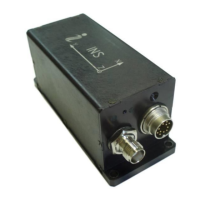INS
GUI User’s Manual
Inertial Labs, Inc
TM
Address: 39959 Catoctin Ridge Street, Paeonian Springs, VA 20129 U.S.A.
Tel: +1 (703) 880-4222, Fax: +1 (703) 935-8377 Website: www.inertiallabs.com
120
Please remember that performed soft and hard iron calibration is valid until
the INS is mounted on the object with which the calibration was performed.
When calibration was accepted then during operation with INS in the “INS
visualization” window (see Fig. 5.1) a capture “Soft/hard iron corrected”
appears in the lower right part of this window. If calibration parameters are
cleared in the INS, then capture “Soft/hard iron corrected” disappears.
10.4.3. Conditions of successful calibration of the INS
Success of the INS calibration on soft and hard iron of the carrier object
essentially depends on magnetic environment at the place where this
calibration is performed.
The best results will be got if calibration is performed in homogeneous
magnetic environment where the magnetic force lines are parallel to each
other. In this case only influence of the carrier object on the INS
magnetometers take place, and this influence can be compensated after
calibration procedure.
However, magnetic environment often is not homogeneous at place where
calibration of the INS is performed. This may lead to degradation of the
calibration results since INS magnetometers are disturbed both by iron of
the carrier object and by curved outward magnetic field. In this case it may
be very difficult to separate influence of these 2 disturbance sources on the
INS.
Inertial Labs engineers have develop special calibration procedure for
separation of these sources of magnetic disturbance to take into account
and compensate just influence of the magnetic field of the carrier object. But
residual influence of non-uniformity of environmental magnetic field may still
decrease calibration accuracy. After a lot of experiments Inertial Labs
engineers have determined acceptable limits of non-uniformity of
environmental magnetic field at which the INS heading accuracy after
calibration is satisfactory.
If the INS calibration procedure was performed in the strict accordance with
procedure described in section 10.4 but calibration is unsuccessful, then
place of the calibration has large distortion of the Earth uniform magnetic
field. To repair this problem please change place of the calibration. For

